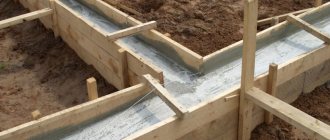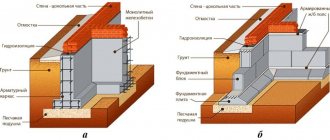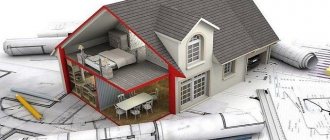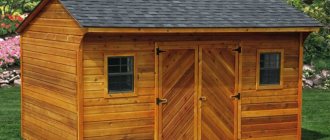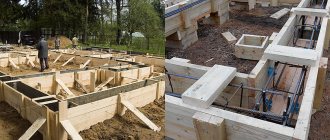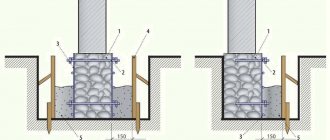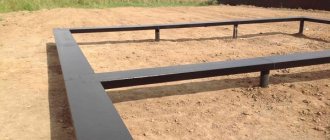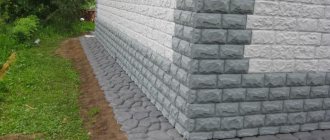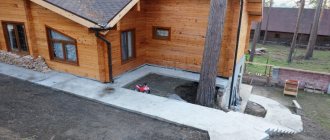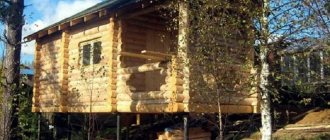The construction of any house is inextricably linked with the construction of a reliable foundation that ensures the stability of the structure. Without information about advanced technologies, some developers construct a strip foundation or build a slab version of the foundation. At the same time, on problematic soils and in conditions of sloping terrain, it is better to build a house on stilts. The screw base is constructed quickly enough, does not require increased costs and provides the necessary load-bearing capacity. Let us consider in detail the features of the technology.
Construction of houses on screw piles - general information
Screw supports are popular among developers constructing buildings on problematic soils. The decision to build a house on screw piles is made in certain situations:
- when the construction site is located on loose soils, soft soils, as well as wet soils with close groundwater;
- with significant differences in heights in the area of the construction site, as well as during the construction of a building in conditions of inclined terrain;
- if there is a lack of financial resources for the purchase of building materials intended for the construction of another type of foundation;
- if necessary, carry out the construction of a light frame structure or wooden house in a limited time;
- if there is no financial opportunity to build a drainage system in swampy soil for building a house.
The reliability and service life of the building depend on the correctly chosen type of foundation.
Screw piles for a house have a simple design and consist of the following elements:
- a steel pipe that takes the axial load from the building;
- working tip welded to the end of the pipe.
The construction of a house on screw piles is carried out according to a certain algorithm. Sequencing:
- Conduct a soil test.
- Develop project documentation.
- Decide on the design and dimensions of the elements.
- Calculate the number of supporting elements.
- Mark the location coordinates.
- Prepare materials, tools and equipment.
- Screw the columns into the ground.
- Trim the pipes to the general level.
- Weld the bearings to the pipes.
- Mount the grillage.
- Insulate the supporting structure.
- Build the building according to the project.
Let's evaluate the features of the technology.
Thanks to this technology, construction can be carried out on water and unstable soils
Types of piles
Before building a house on screw piles, you need to decide on the type of supports, material of manufacture and method of deepening. Piles are divided into types depending on the following factors:
- Use of material in the production of supports: reinforced concrete, concrete, dense bentonite or local clay, steel (pipes, rails, etc.), soil (clay), wooden logs, a combination of several materials.
The type of piles is chosen depending on the type of structure and the nature of the soil - Support shape: round, square, trapezoidal, prism-shaped, with an extended lower edge.
- Depth, weight, diameter thickness depend on the freezing point of the soil, the proximity of groundwater, and the weight of the building. Solid 12-20 m products are used, composite, spliced from several parts using clamps or welding. The shape of the bottom edge is made open or closed with a special tip.
- According to the method of redistributing loads on the soil, they are divided into vertical (they transfer the entire load from the building to a dense layer of soil located under an unstable layer), hanging ones are installed obliquely (the load is transferred through the friction of the earth on the uneven surface of the pile wall).
The choice of piles for foundation construction depends on many factors; the reliability and service life of the house depends on how correctly the choice is made.
Building a house on screw piles - design features
The basic element of the foundation is tubular elements with a spiral tip. The construction of houses on screw piles is carried out using supports of various designs. They differ in the shape of the working tip.
The profile could be as follows:
- standard, in the form of one full turn welded in the pipe. It is part of the foundations of light buildings;
- reinforced, consisting of two intermittent turns welded to the pipe. Able to withstand increased loads;
- narrow-blade, made in the form of a cast conical nozzle. Suitable for rocky soils;
- cylindrical in the form of a continuous spiral of constant diameter. Designed to work in permafrost conditions.
Before building a house on screw piles, you need to decide on the type of supports.
A special feature of a screw foundation is the immersion method. The piles are not driven into the soil by successive blows, but are screwed by applying a torque. As the pipe rotates, its cone-shaped tip gradually moves deeper into the soil. Reliable fastening is facilitated by compaction of the rock during the screwing process.
When choosing piles for your home, you need to consider the following points:
- grade of steel used for their manufacture;
- thickness of the coil in the working part;
- the size of the pipe wall, which determines its durability;
- quality of welds in the nozzle attachment area;
- the shape of the working blades and the total length of the support element.
The load from the mass of the structure is evenly distributed across all columns. This is achieved by leveling the tops of the pipes and securing the ends. A grillage is attached to the supports, which unites the columns into a common power circuit.
To make a grillage, choose one of the following materials:
- steel channels or I-beams;
- wooden beams;
- concrete blocks.
Such a foundation is reliable. After all, the load from the building is transferred to the grillage, which rigidly connects the columns. A quickly erected foundation allows the construction of a house to be completed in a limited time.
A pile foundation includes a group of piles interconnected by a grillage
Types of pile foundations
Piles are placed singly or as whole pile bushes.
Piles are long vertical elements immersed in the ground in order to transfer the load-bearing load from the building to them.
A pile foundation includes a group of piles interconnected by a grillage, ensuring uniform load distribution.
Depending on the location of the piles, foundations are divided into types:
- the ribbon arrangement includes supports located along the entire perimeter of the building and united by a grillage;
- single piles support light frame buildings;
- pile bushes require a group arrangement and are laid in the form of columns, pillars, or individual supports;
- pile fields are multi-storey structures and may include elements from the above types.
The piles are laid below the freezing point of the soil, this protects the foundation from deformation during soil heaving.
House on stilts - advantages of screw supports
When you decide to build a house on stilts, understand the advantages of these supports and their weak points. A house on stilts has the following advantages:
- not picky about soil. It can be built with a high concentration of clay and sand in the soil, as well as on wet soils and quicksand;
- does not depend on the influence of natural factors. Remains stable during temperature fluctuations, frost heaving of soil, shrinkage and soil erosion;
- requires small cash costs associated with the construction of the foundation. A pile field made of supporting elements is a budget solution;
- erected in a short time. After installing the pile elements, the installation of which will take no more than 2 days, construction can begin;
- can be built at any time of the year. The technology of immersion of screw supports into the ground allows work to be carried out in any weather conditions;
- low labor intensity. The design of the pile foundation allows you to build it yourself without the use of special construction equipment;
- can be erected near an existing building. This eliminates the possibility of shrinkage and negative influence of nearby buildings.
The undoubted advantages of columns also include:
- the ability to dismantle supporting elements and reuse them;
- absence of shrinkage, which allows to significantly speed up the construction cycle;
- simplicity of technology that does not require special construction preparation.
The design of this foundation makes it possible to build houses in conditions of sloping terrain, as well as in the absence of access roads for large construction equipment.
The material for making supports is used depending on the type of soil
Construction of the blind area
To protect the house from moisture penetration, it is necessary to install a blind area. The blind area is usually poured from concrete around the entire perimeter of the house.
The blind area is formed with a slope from the foundation walls. The blind area is poured depending on the specifics of the soil and the protrusion of the cornices. According to reviews from professionals and recommendations from SNIPs, the blind area cannot be narrower than one meter. The depth of the blind area is about 25 cm.
To fill the blind area, you need to make a simple calculation and find out its required width. To do this, add at least 30 cm to the extreme point of the protruding cornice.
Installation of a blind area under the foundation on piles
It is necessary to dig a trench to a depth of about 25 cm along the entire perimeter of the house, then raise the formwork and make a sand cushion.
Calculation of the required amount of sand is simple: L blind area x B blind area x 0.1 m (height of the poured layer of sand).
Next we fill in a layer of crushed stone. In order to determine how much crushed stone is needed to install a blind area, let's make a calculation: L blind area x B blind area x 0.05 m (height of the crushed stone layer).
Reinforced mesh must be laid on top. The resulting structure is filled with concrete with the required slope height.
Scheme of the blind area of the pile foundation
To purchase the required quantity, we first determine how much concrete is needed using the following calculation: L blind area x B blind area x 0.1 m (height of the concrete layer).
According to experts, piles, if all construction processes are followed, can stand for quite a long time. But periodically it is necessary to inspect the condition of the piles in order to react in time to the beginning of deformation and replace them, preventing premature overturning of the structure.
House on screw stilts - weak points of supports
Along with the advantages, the pile-screw type foundation has a number of disadvantages:
- gradual destruction of supporting columns as a result of corrosion;
- low load capacity on light types of soil;
- the difficulty of screwing elements into soil with a high stone content;
- the need for additional anti-corrosion protection of the working surface;
- inability to assess the condition of an element embedded in the soil;
- the difficulty of organizing a basement in a building on screw columns;
- the need to carry out work on geodetic soil surveys;
- the service life of the columns has been reduced to five decades;
- involvement of designers to develop a detailed design.
Disadvantages also include the increased likelihood of using columns made in artisanal conditions from low-quality materials.
Selecting the type of supports
Reinforced concrete piles can support the weight of a multi-story building.
In heaving, water-saturated soil with a significant freezing depth, laying a pile foundation is considered the best option.
The material for making supports is used depending on the type of soil and geological features of the area.
Wooden logs installed in fresh water or in soil at a depth below the water table will last more than 50 years without changing their load-bearing capacity. But with frequent changes in humidity (they are either moistened or dried out), the wood begins to decompose and loses its qualities within a short period of time.
Metal supports can be installed in any type of soil and on water. A prerequisite is treatment with anti-corrosion compounds and installation at a depth below the freezing point of the soil. It is more economically and technologically advantageous to install hollow screw piles.
Reinforced concrete supports can support the mass of multi-story buildings with large numbers of floors. If the installation technology is followed, the service life is more than a century.
In soils subject to horizontal shear, the use of a columnar foundation is not recommended, since the movement of the soil can push and overturn the building. If the construction site has an uneven surface, it is necessary to install a rigid reinforced concrete pad between the supports to prevent lateral movement of the structure.
Comparative characteristics of strip and pile-screw foundations
How to build a house on stilts
Having assessed the positive aspects and analyzed the weak points of the foundation, you need to determine whether the selected foundation design is suitable for your building.
Building a country house on stilts has many advantages
This technology ensures the stability of lightweight buildings and structures that can be assembled independently in a limited time:
- frame buildings;
- log baths;
- utility blocks;
- various canopies;
- verandas;
- exit gate;
- wooden and mesh fences.
Let's consider the main stages of constructing a foundation for building a house:
- calculation part;
- immersion in the soil;
- grillage installation;
- insulation of the lower level.
Let us dwell on the features of each stage of work.
Reasons for this strategy
- adaptation to uneven topography;
- preservation of original local “inhabitants” such as trees, shrubs and boulders;
- construction on a floodplain, where the soils are usually not hard and stable;
- preservation of the natural drainage layer;
- use of a passive cooling system in warm climates;
- adaptation to a remote structure or difficult access for equipment used to build the foundation;
- reduced costs due to less use of materials;
- prevention of rot, mold and insects at the interface with the soil.
Calculating the number of supports
Before design begins, geodetic surveys should be carried out, which include:
- soil sampling and analysis;
- determination of the depth of aquifers.
The load capacity is then determined. For non-critical structures, you can use tabular load capacity indicators for various standard sizes of columns.
Almost all types of pile foundations are designed to withstand the load from low-rise buildings
Let's look at examples:
- a screw support, made on the basis of a pipe with a diameter of 76 mm with a working part diameter of 200 mm, can withstand 1000 kg;
- when the pipe diameter increases to 89 mm and the size of the spiral part to 250 mm, the design load accordingly increases to 2000 kg;
- an element based on a pipe with a diameter of 108 mm and a working part diameter of 300 mm has a load capacity of 250 kg.
The general calculation algorithm involves performing the following work:
- Determination of the mass of the structure. It is calculated by multiplying the volume of the walls by the density of the building material. The mass of the roof and interior elements should be added to the resulting value.
- Calculation of snow load. To calculate the indicator, it is necessary to multiply the roof area of the building by the standard value of the snow load for a particular region.
- Calculation of dynamic load. The value is determined by multiplying the base area by the base value of 350 kg per square meter of surface.
It is also necessary to take into account the wind load. It is determined from tables that take into account the maximum wind speed for a specific region. Having summed up all types of loads acting on the structure, we obtain the total total load perceived by the foundation.
The strength and durability of the house depends on the quality of the material used
. Further procedure:
- Draw a plan of the building, distributing supports in corner areas and under supporting structures.
- Divide the total load by the total number of columns and calculate the load per element.
- Select the design of the supports used, focusing on their load-bearing capacity with a safety factor of 1.2.
When performing calculations, it is necessary to round all values towards a larger value.
Hybrids
Any of the above elements can be used together if the construction area turns out to be too difficult to handle. The fact is that a person is accustomed to living in conditions of rectilinear planes, therefore, when constructing housing, he makes the maximum amount of effort to level all surfaces. Only then can he be confident in the reliability of his own living space, not forgetting to admire the imperfect shapes of the surrounding hills.
Screwing piles for the house
Follow the specified sequence of actions when screwing:
- Mark and prepare the pits.
- Install the supports sequentially.
- Attach the screwing device.
- Screw in the supports, making sure they are vertical.
- Compact the soil around the column.
- Mark the height of the pipes and cut off the excess part.
- Fill the internal cavities with cement mixture.
After the solution has hardened, install and weld the ends to the top of the pipe.
When choosing a support, you need to study the relationship between the type of soil and the load-bearing load of the pile
Advantages and disadvantages of screw piles
Screw piles are metal pipes, one side of which has a conical shape, the opposite is equipped with holes for levers used to screw the pile into the soil. The lower conical end of the metal pipe is hermetically sealed, after which blades are added to it. Also included are heads that allow you to attach the frame beams (grillage). To increase the reliability of the material, the pipes are coated with special anti-corrosion compounds that extend the service life of the piles.
The use of screw piles has the following advantages in comparison with other types of foundation (strip and column).
- High speed of construction (a few days are enough for construction).
- Reduced costs for creating a solid foundation (savings are about 20-40%).
- The walls of a private house can be erected immediately upon completion of the pile binding.
- When working with piles, there are no difficult and time-consuming excavation work that requires the use of special equipment.
- When installing piles, the earth is not loosened, but compressed, which increases the bearing capacity of the soil.
- Construction of housing is possible both on soft soils with groundwater and in areas with difficult terrain.
At the same time, screw piles, like any other material, are not without disadvantages, including:
- Difficulties in arranging a basement.
- Floors need high-quality insulation.
- If the protective layer is damaged, the metal is susceptible to corrosion processes.
- Piles are not used on stony and rocky soils.
We install the grillage
One of the common grillage options is a structure based on a wooden beam.
Using the example of using a beam with a cross section of 15x15 cm, we will consider the sequence of installation actions:
- Soak the wooden beam with an antiseptic.
- Place the beam on the end platforms.
- Join the beams with minimal gap.
- Secure the lower crown with self-tapping screws.
- Lay the cross beams.
- Connect them to the bottom outline.
- Waterproof the wood with mastic.
- Cover the end part of the grillage with boards.
This grillage design is double. A single option is possible, when the joining of longitudinal and transverse beams is made at the ends.
Construction of a foundation made of screw piles
As mentioned earlier, screw piles are steel pipes with a special anti-corrosion coating. The length of the material with a cone-shaped end and blades is from 2.5 to 9 meters. Often a few people are enough to screw the pile into the ground, but in more problematic soils the use of machinery will be required. As for purchasing piles, you need to entrust this to experienced builders or do it yourself by going to a trusted store where they can provide documents confirming the quality of the material. In the optimal case, the seller must present certificates confirming the high quality of the metal and its resistance to corrosion, which determines the durability of the base and the house as a whole.
Before proceeding with the installation of piles, you need to go through preparatory procedures, which include the following steps:
- Creating a plan and drawing.
- Calculation of the depth of piles, calculation of the required number of elements.
- Engineering-geological surveys, during which the features of the relief will be studied.
- Calculating the weight of the future wooden structure.
- Purchasing material of proven quality.
- Preparing the area for work and clearing the soil.
- Marking the territory using ropes and pegs.
To create a strong, stable and durable foundation, screw piles are buried into the ground no less than 1.5 meters (to the depth of soil freezing or deeper to solid ground). As for the number of piles, a calculation is made taking into account that they should be located in the corners and perimeter of the house, in the places where the internal walls adjoin the external frame and along the external and internal walls. Distance between steel supports (1.5-3 meters).
Having installed the piles, it is necessary to cut their upper part to the height of the foundation and pour concrete into the hollow part of the pipe, which will increase the bearing capacity of the supports. After this, you need to weld the heads, on top of which you can attach wooden or metal beams. Having completed the procedure, you can proceed to forcing the walls and further construction work.
We thermally insulate the supporting part
Insulate the lower part according to the following algorithm:
- Install the sheathing frame.
- Secure the rough sheathing from boards or slabs.
- Make ventilation ducts in it.
- Attach polystyrene foam to the rough sheathing.
- Secure the decorative sheathing over the insulation.
- Install protective pads and visors.
The effectiveness of thermal insulation is influenced by properly performed waterproofing of the soil, as well as insulation and vapor barrier of the floor of the building.
Foundation insulation
After installing both bored and screw piles, it is necessary to make good insulation of the open space between the floor and the ground, and arrange a basement there.
After all, with a pile foundation, the floor remains an open space and if it is not well insulated, then in the winter the floor will be not just cold, but icy. You need to be prepared for the fact that the cost of insulation will be much more expensive than the purchase and installation of the piles themselves.
First of all, the grillage is waterproofed. It is necessary to lay timber along the entire perimeter of the house as a base for the subfloor.
To save money, the subfloor can be made from a flat, unedged board, because its price is insignificant.
The subfloor is laid on joists. The space between the joists must be filled with insulation; according to experts and users, this layer cannot be less than 150 mm.
A thinner layer of insulation will not be able to fully ensure the preservation of heat in the future room. It is advisable to treat the boards with an antiseptic to protect the floor from moisture and mold.
At the bottom of the beam, as a rule, a liner of boards or plywood is stuffed, a waterproofing layer, several layers of foam plastic or other insulation are secured. Then the subfloor is laid and plywood or chipboard is mounted on top.
The base can be made of stone, brick or concrete. The base can be:
- sinking;
- speaker;
- fused.
The basement also needs insulation and will require additional costs, because the basement will need to not just be covered with timber, but to make a reliable structure that can withstand the flow of water as a result of melting water in the spring and the wet summer, when heavy rains fall incessantly.
Project of a one-story frame house on stilts
And the last stage is cosmetic. The base will also require exterior finishing. This can be done with facade panels, corrugated sheets or any other durable material.
